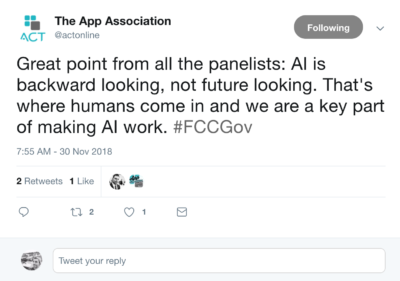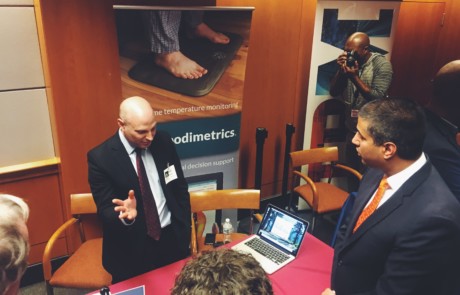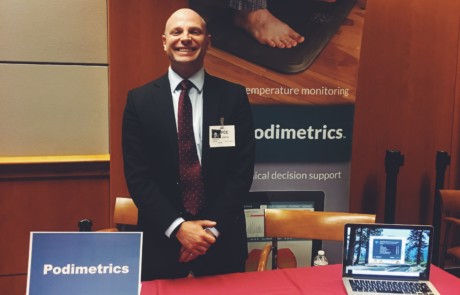“Prepare for failure, yell and do not expect anything.” “Before inspiration, comes the slaughter.” “Seek success, but prepare for vegetables.” No, these are not bizarre threats or samples of Kanye West’s tweets, these are quotes created by Inspirobot, an artificial intelligence (AI)-driven bot that was designed to create inspirational and uplifting messages. This example of AI gone awry serves as an important reminder that AI, while capable of life-changing behaviors and actions, is still just a machine that learns behaviors from its creators. Therefore, humans will always be a part of defining what AI can do.
Recent (successful) developments in AI and machine learning have captured the attention of lawmakers and regulators across DC. Chairman Ajit Pai of the Federal Communications Commission (FCC) recently convened the “Forum on Artificial Intelligence and Machine Learning” to better understand the challenges and opportunities surrounding AI. We attended with member company Podimetrics to discuss what AI and machine learning are, the future of these technologies, and their implications for the marketplace.
AI: A Brief History
The forum kicked off with a keynote from Subbarao “Rao” Kambhampati, professor of Computing, Informatics, and Decision Systems Engineering at Arizona State University. Professor Kambhampati’s keynote focused on reminding us that the concept of AI and machine learning has been around a long time – in fact, one of the first mentions of AI was in 1956! The commercialization of high-performance computing took AI from an advanced, foreign piece of technology made for data scientists, and turned it into a basic tool that anyone who has an email address can access. But while AI has a history longer than most assume, Professor Kambhampati reminded the attendees that its place in mainstream consciousness didn’t take off until around the early ‘80s, when it became rule-based systems for businesses that handle a lot of data. In the mid- ‘90s, AI transformed to a reasoning systemhink IBM’s chess-playing tool “Deep Blue,” one of the first uses of AI to capture popular culture’s short attention span.) By the ‘00s, perceptual tasks like face recognition became part of AI’s growing capabilities and added to a growing collection of worries that AI represented a “killer robot” future.
“Amplify & Empower” Not “Destroy & Devour”
While it’s easy to fixate on the possibilities that come with AI, there are limits to what it can do.
Carolyn Nguyen, director of technology at Microsoft, kicked off the first panel with an important clarification saying, “AI can help us establish better insights and empower all of us to create better solutions. Basically, transform whatever it is that we’re doing into something that is much better than what we were doing before.” For example, a farmer in rural Washington can use AI precision tools to measure temperature, pH, and moisture levels of the soil. AI then gives the farmer information, but it’s up to the farmer to use experience and forward-looking information to make the decisions how many and what types of crops to plant, or how often to water. AI is not replacing the farmer; AI is amplifying the efforts of the farmer. Many of the other panelists agreed with her assessment. While AI may take over more and more data analysis for humans, that free time allows us to do what we do best—create, dream, and continue to find novel applications for technology.
“AI can help us establish better insights and empower all of us to create better solutions. Basically, transform whatever it is that we’re doing into something that is much better than what we were doing before.”
AI and Health
Podimetrics, a Boston-based member company, took this opportunity to showcase their AI-enabled connected health tool aimed at reducing foot ulcers in diabetic patients. Their FDA-approved SmartMat™ technology monitors patients’ baseline foot temperatures, requiring them to stand on the mat for just 20 seconds a day. After the patient stands on the mat, the system sends their data securely to the cloud where the AI-enabled Remote Temperature Monitoring System™ analyzes patients’ foot temperatures to identify potential asymmetries or “hotspots” – the first signs of an ulcer. If a hotspot is detected, the system has a custom protocol that will notify the patient’s physicians and healthcare providers for appropriate treatment. This technology uses machine learning and works with physicians to save the limbs, and ultimately the quality of life, of thousands of diabetic patients a year.
AI and machine learning is the future, and it is our responsibility as innovators, policymakers, and humans to understand this emerging technology. We applaud the FCC’s efforts in learning more about AI by holding events like the “Forum on Artificial Intelligence and Machine Learning” and look forward to many more.




